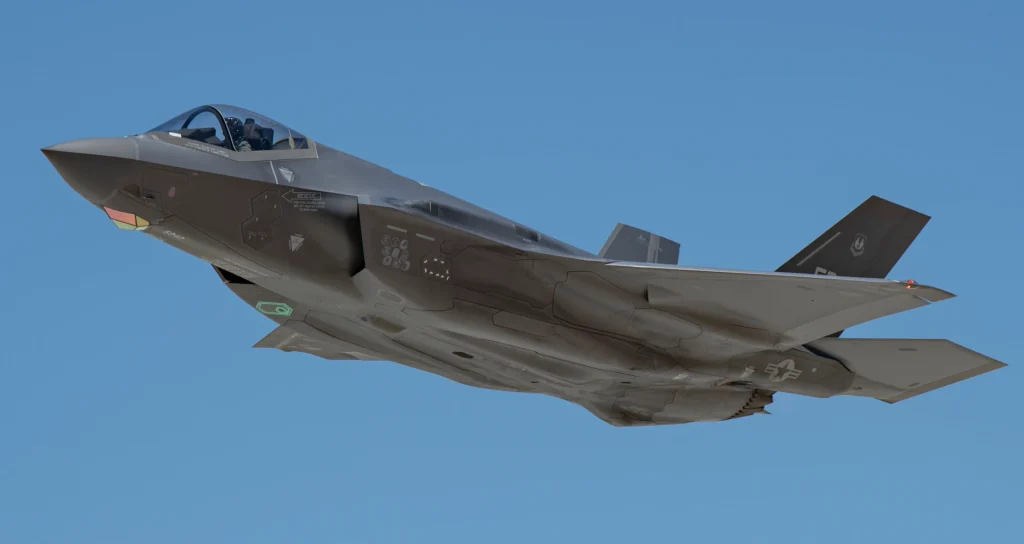A South Korean Airforce F-35A fighter aircraft made an emergency landing on the fuselage due to a problem with its electronic systems during a training flight at the Seosan airbase in the country’s west.
The fat looking US-made fifth-generation stealth aircraft was spared serious damage to its fuselage thanks to the foaming of the runway, and the pilot escaped unharmed.
Shin Ok-Chul, Deputy Chief of Staff of the Korean Air Force, shared the details of the incident in a session in the parliament.
The pilot of the low-flying F-35 suddenly heard noises and controlled the systems. As per Shin, the pilot, who saw that all systems had stopped except the flight control and engine, preferred to land on the fuselage instead of using the ejection seat.
Shin stated that the incident was the first time an F-35 fighter plane landed on the fuselage.
The fault brought down the entire fleet
South Korean army officials stated that a joint investigation will be launched with the United States regarding the malfunction and that the fleet of 30 F-35s will not be flown until the investigation is concluded.
F-35 accidents
F-35s, considered the most expensive combat vehicle developed by the USA, have been involved in 8 accidents.
The last time in November 2021, an F-35B model fighter jet belonging to the British Navy crashed into the Mediterranean while taking off from the aircraft carrier HMS Queen Elizabeth. The pilot survived the incident.
South Korean F-35 fleet
South Korea ordered 40 F-35s from the U.S. arms company Lockheed Martin in 2014 and received 30 of them in 2019.
The upgrades issue
Just after two years since the acquisition of the first F-3A, in March 2021, the SOKO media reported that the United States had given the notice to improve its performance. The cost is 300 billion won, which is more than the price of three or four F-35s and will go on till 2030.
The first performance improvement is to install additional weapons-related equipment such as air-to-ship missiles and upgrade avionics software. This project was approved in June 2021.

Where does the SOKO F-35 go for repairs and upgrades?
As per the South Korean Airforce, there is a Lockheed Martin maintenance team in Korea and the Air Force mechanics have been trained in the United States. This team takes care of the essential maintenance.
But if the aircraft needs disassembly or stealth coat painting, it must go to a maintenance depot by Lockheed Martin. When the plane is more than five years old, it must go to the designated depot with MRO&U (maintenance and equipment upgrade) authority.
Currently, Lockheed Martin has designated such MRO&Us in Japan, Australia, and the United States. But sending the planes to Japan is a sensitive issue for the Koreans due to the turbulent past. At the same time, the cost of maintenance to Australia or the United States is huge. If the Korean F-35A uses the MRO&U of Australia rather than Japan, the Korean F-35A must travel about 8,500 km one way and about 17,000 km round trip every time it undergoes major maintenance. One flight will take you directly to MRO&U in Williamstown, Australia. So it is realistic to fly from the Cheongju Air Base in South Korea to Guam Air Base of the U.S. to Townsville Air Base in Australia and finally to Williamstown Course. In this case, it is expected to take at least three days or six days round trip.
No live firing as there is no ammunition
Since its purchase, the South Korean Air Force’s F-35A has operated without live cannon ammunition. The Defense Acquisition Program Administration signed a contract to purchase ammunition for the F-35A 25mm cannon with the U.S. military in December 2015. However, it was found that only practice ammunition was contracted and not live ammunition. The U.S. did not certify whether the Korean Air Force could use live ammunition. The certification was received in 2018 belatedly DAPA has been asking the U.S. military for the purchase of live ammunition. But it is known that the actual time of its introduction is unclear.
The bomb used for education and training is different from the actual bombs, so it is difficult to penetrate or destroy the target, and the lethality is also low.
Plans of F-35B
The South Korean military has decided to import vertical take-off and landing stealth fighters to be deployed on light aircraft carriers.
SOKO plans to purchase an additional 40 F-35’s, and 20 of them are planned to be the F-35B vertical take-off and landing version that the ‘Korean-style light carriers can deploy.
The Navy plans to complete the construction of the light carrier LPX-II by 2030. As per the Korean officials, detailed information on the F-35B is absolutely necessary for the design of major parts of the hull, such as the deck.
